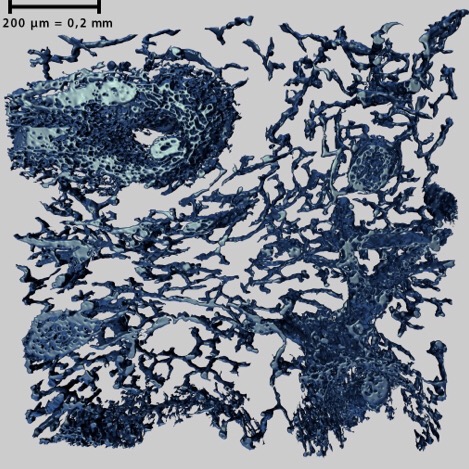ACADEMIA
University of Bayreuth's Guthe creates high-resolution process for 3D images of the smallest blood vessels

An interdisciplinary team from the Universities of Bayreuth and Marburg has accomplished a feat that was not previously possible, even using the newest medical imaging techniques: a high-definition image of the smallest blood vessels, which are found in organs such as the spleen or bone marrow of human beings. The researchers have developed a process for visualizing the highly complicated network of such blood vessels in tissue samples in 3D. On how the new technique works, they report in Medical Image Analysis and PLOS ONE.
The scientists working with Prof. Dr. Michael Guthe and Dr. Oleg Lobachev in Bayreuth (Computer Science) and Prof. Dr. Birte Steiniger in Marburg (Anatomy) utilize a method referred to as “immunohistology” in medicine and biology. This process enables molecules that are only found in cells in the inner walls of blood vessels to be visibly marked. However, this is only possible thanks to fine sections which are removed from a tissue sample using a special cutting device and which are only five to seven thousandths of a millimetre thick. In the new process developed in Bayreuth and Marburg, the tissue sections are first photographed using a scanning microscope. After that, the images of a whole ordered series of sections must be precisely overlaid to reconstruct the three-dimensional arrangement of the blood vessels. However, a fundamental difficulty arises in this context: the extreme thinness of the sections causes the tissue to contort during cutting. Various distortions occur within each individual section, making it difficult or impossible to correctly piece together adjacent sections in the series. Realistic images via a new software system
The computer scientists in Bayreuth have now succeeded in providing a reliable solution to this problem with the help of a software system they developed. After the data is automatically filtered by the system, it is sent to a high-performance computer and converted into high-resolution 3D images. In this process, the proportions of the blood vessels are not distorted. “Our process is of great interest to basic research in medicine, which has not yet been able to provide a precise description of the complex network of blood vessels in the spleen and in the bone marrow. However, with the current state of technology, it is still too slow to be used for medical diagnosis since it requires processing enormous amounts of data,” Prof. Guthe explained.
The analyses carried out to date have already led to some surprising findings. For example, it turns out that the smallest blood vessels in the spleen are open-ended and that blood flows outside blood vessels for a short distance. In the haematopoietic marrow of the iliac crest, both of the two known types of the smallest blood vessels (capillaries and sinuses) most likely run in parallel and not in series. It was also shown which antibodies have be used to detect both types of blood vessels simultaneously to visualize all of the smallest vessels in bone marrow. “One factor that made our research project possible was the donation of marrow samples from the iliac crest by the Department of Oral and Maxillofacial Surgery in the Phillipps University Hospital of Marburg – with the consent of the patients and the relevant ethics committee. These samples had been left over from operations in which bone was reconstructed using material from the iliac crest. Other tissue samples were from patients whose spleens had to be removed due to life-threatening fissures that resulted from abdominal trauma,” Prof. Steiniger said.
The focus of further research projects: lymphocytes
The research groups in Bayreuth and Marburg plan to examine small vessels in other lymphoid organs such as spleen or tonsils. In addition, they are interested in lymphocytes. These white blood cells, which are crucial to the immune system, form round accumulations in the lymphoid organs called “follicles”. Lymphoid follicles have a diameter of about one millimetre. “One millimetre is a huge distance in terms of microscopy, necessitating several hundred serial sections for reconstruction. We are thus trying to make due with less serial sections, in order to analyse different types of cells in an entire follicle,” Prof. Guthe explained. The researchers hope to explain how lymphocytes work together in follicles in immune reactions and how they travel to and from lymphatic tissues and mucous membranes.
